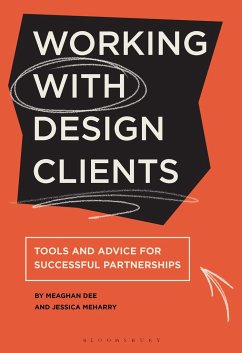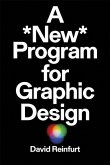- Gebundenes Buch
- Merkliste
- Auf die Merkliste
- Bewerten Bewerten
- Teilen
- Produkt teilen
- Produkterinnerung
- Produkterinnerung
A practical manual for working with real world clients and briefs in the university design studio setting.
Andere Kunden interessierten sich auch für
![On Design On Design]() Tevfik BalciogluOn Design99,99 €
Tevfik BalciogluOn Design99,99 €![Designing for Local Communities Designing for Local Communities]() Meaghan BarryDesigning for Local Communities75,99 €
Meaghan BarryDesigning for Local Communities75,99 €![Elegant Design Elegant Design]() Luca IandoliElegant Design108,99 €
Luca IandoliElegant Design108,99 €![The Professionalization of Window Display in Britain, 1919-1939 The Professionalization of Window Display in Britain, 1919-1939]() Kerry MeakinThe Professionalization of Window Display in Britain, 1919-1939113,99 €
Kerry MeakinThe Professionalization of Window Display in Britain, 1919-1939113,99 €![A New Program for Graphic Design A New Program for Graphic Design]() David ReinfurtA New Program for Graphic Design12,99 €
David ReinfurtA New Program for Graphic Design12,99 €![What's Behind Your Brand? What's Behind Your Brand?]() Jen O'RyanWhat's Behind Your Brand?21,99 €
Jen O'RyanWhat's Behind Your Brand?21,99 €![What's Behind Your Brand? What's Behind Your Brand?]() Jen O'RyanWhat's Behind Your Brand?20,99 €
Jen O'RyanWhat's Behind Your Brand?20,99 €-
-
-
A practical manual for working with real world clients and briefs in the university design studio setting.
Produktdetails
- Produktdetails
- Verlag: Bloomsbury Academic
- Seitenzahl: 224
- Erscheinungstermin: 3. Oktober 2024
- Englisch
- Abmessung: 231mm x 168mm x 17mm
- Gewicht: 640g
- ISBN-13: 9781350358836
- ISBN-10: 1350358835
- Artikelnr.: 70361170
- Herstellerkennzeichnung
- Libri GmbH
- Europaallee 1
- 36244 Bad Hersfeld
- gpsr@libri.de
- Verlag: Bloomsbury Academic
- Seitenzahl: 224
- Erscheinungstermin: 3. Oktober 2024
- Englisch
- Abmessung: 231mm x 168mm x 17mm
- Gewicht: 640g
- ISBN-13: 9781350358836
- ISBN-10: 1350358835
- Artikelnr.: 70361170
- Herstellerkennzeichnung
- Libri GmbH
- Europaallee 1
- 36244 Bad Hersfeld
- gpsr@libri.de
Meaghan Dee and Jessica Meharry
Introduction
Part 1: Why
1. Learning Through Experience
This chapter situates client work in the design classroom within a larger
educational context by addressing learning-through-doing, project outcomes,
and a variety of styles of studio
2. Connecting to Industry
Explores the relationship between client-based experiences and an overall
design education. The chapter connects these experiences to current
marketplace demands and alternative models for design practice, as well as
hearing advice from professionals working in industry
3. Becoming Empowered (including input from Najla Mouchrek)
Studio experiences can provide a sense of agency and purpose when students
take on responsibilities of guiding real-world clients and community
interactions. This chapter covers empowerment, mentorship, power sharing
and collaborations
Part 2: What
4. Engaging with Communities
This chapter explores a range of approaches to ethical community and client
engagement through real-world project experiences. Throughout this chapter
we will identify strategies for "designing with, not for" communities and
provide a deep examination of ethical and value considerations
5. Finding Focus and Targeting Communities
This chapter addresses framing the scope of projects, the types of clients
and partners, and approaches to various contractual arrangements
6. Achieving Learning Goals
There are a vast ranges of approaches to how, when, and where these
experiences happen for students, from single projects within a class, to
capstone-level practicum courses, to independent, standalone studios.
Through a series of surveys and interviews, we show real- world examples of
each model and outline options for how to establish client relationships
and studio experiences based on a program's unique needs and intentions
Part 3: Who
7. Exploring Work Roles
This chapter identifies the responsibilities that students, faculty, and
assistants assume as well as the strategies for dealing with the workload
related to those responsibilities. Real-world clients bring real-world
challenges. As such, this chapter offer strategies for dealing with
conflicts, how to effectively collaborate, and how to structure student
teams
8. Working With Clients
This chapter uncovers the nuts and bolts of working with clients. The best
way to build and maintain strong client relationships is to establish clear
communication. Designers must listen to clients and be able to articulate
and confirm expectations. Instructors must align client work with learning
outcomes and student expectations. Students must also develop knowledge and
skills in project management and financial management, including how to
analyze and create contractual documents and creative briefs
9. Articulating Value
In this chapter, readers will be guided through strategies to articulate
the value (both monetarily and educationally) to stakeholders
Part 4: How
10. Launching the Studio
This chapter outlines best practices and strategies for a successful launch
(or re-launch) of a full-fledged, student-run campus design studio
11. Managing the Money
This chapter addresses the operations and logistics of advising and
operating a student-run campus design studio. In this chapter, we share
findings from our interviews and research that outline a range of practices
that have worked for those who are actively guiding these experiences
12. Planning for the Future
This chapter addresses the challenges and best practices of studio
operations when taking over an existing studio and for when pivoting
directions with your current studio. Based on interviews and case studies,
we outline best and worst case scenarios. We include a discussion of how to
handle the hand-off between firms, turning repositioning into a design
project, and collaborating with other firms within an institution. We
conclude by providing tools to help you create a future vision for your
ideal studio
Conclusion and Resources
Part 1: Why
1. Learning Through Experience
This chapter situates client work in the design classroom within a larger
educational context by addressing learning-through-doing, project outcomes,
and a variety of styles of studio
2. Connecting to Industry
Explores the relationship between client-based experiences and an overall
design education. The chapter connects these experiences to current
marketplace demands and alternative models for design practice, as well as
hearing advice from professionals working in industry
3. Becoming Empowered (including input from Najla Mouchrek)
Studio experiences can provide a sense of agency and purpose when students
take on responsibilities of guiding real-world clients and community
interactions. This chapter covers empowerment, mentorship, power sharing
and collaborations
Part 2: What
4. Engaging with Communities
This chapter explores a range of approaches to ethical community and client
engagement through real-world project experiences. Throughout this chapter
we will identify strategies for "designing with, not for" communities and
provide a deep examination of ethical and value considerations
5. Finding Focus and Targeting Communities
This chapter addresses framing the scope of projects, the types of clients
and partners, and approaches to various contractual arrangements
6. Achieving Learning Goals
There are a vast ranges of approaches to how, when, and where these
experiences happen for students, from single projects within a class, to
capstone-level practicum courses, to independent, standalone studios.
Through a series of surveys and interviews, we show real- world examples of
each model and outline options for how to establish client relationships
and studio experiences based on a program's unique needs and intentions
Part 3: Who
7. Exploring Work Roles
This chapter identifies the responsibilities that students, faculty, and
assistants assume as well as the strategies for dealing with the workload
related to those responsibilities. Real-world clients bring real-world
challenges. As such, this chapter offer strategies for dealing with
conflicts, how to effectively collaborate, and how to structure student
teams
8. Working With Clients
This chapter uncovers the nuts and bolts of working with clients. The best
way to build and maintain strong client relationships is to establish clear
communication. Designers must listen to clients and be able to articulate
and confirm expectations. Instructors must align client work with learning
outcomes and student expectations. Students must also develop knowledge and
skills in project management and financial management, including how to
analyze and create contractual documents and creative briefs
9. Articulating Value
In this chapter, readers will be guided through strategies to articulate
the value (both monetarily and educationally) to stakeholders
Part 4: How
10. Launching the Studio
This chapter outlines best practices and strategies for a successful launch
(or re-launch) of a full-fledged, student-run campus design studio
11. Managing the Money
This chapter addresses the operations and logistics of advising and
operating a student-run campus design studio. In this chapter, we share
findings from our interviews and research that outline a range of practices
that have worked for those who are actively guiding these experiences
12. Planning for the Future
This chapter addresses the challenges and best practices of studio
operations when taking over an existing studio and for when pivoting
directions with your current studio. Based on interviews and case studies,
we outline best and worst case scenarios. We include a discussion of how to
handle the hand-off between firms, turning repositioning into a design
project, and collaborating with other firms within an institution. We
conclude by providing tools to help you create a future vision for your
ideal studio
Conclusion and Resources
Introduction
Part 1: Why
1. Learning Through Experience
This chapter situates client work in the design classroom within a larger
educational context by addressing learning-through-doing, project outcomes,
and a variety of styles of studio
2. Connecting to Industry
Explores the relationship between client-based experiences and an overall
design education. The chapter connects these experiences to current
marketplace demands and alternative models for design practice, as well as
hearing advice from professionals working in industry
3. Becoming Empowered (including input from Najla Mouchrek)
Studio experiences can provide a sense of agency and purpose when students
take on responsibilities of guiding real-world clients and community
interactions. This chapter covers empowerment, mentorship, power sharing
and collaborations
Part 2: What
4. Engaging with Communities
This chapter explores a range of approaches to ethical community and client
engagement through real-world project experiences. Throughout this chapter
we will identify strategies for "designing with, not for" communities and
provide a deep examination of ethical and value considerations
5. Finding Focus and Targeting Communities
This chapter addresses framing the scope of projects, the types of clients
and partners, and approaches to various contractual arrangements
6. Achieving Learning Goals
There are a vast ranges of approaches to how, when, and where these
experiences happen for students, from single projects within a class, to
capstone-level practicum courses, to independent, standalone studios.
Through a series of surveys and interviews, we show real- world examples of
each model and outline options for how to establish client relationships
and studio experiences based on a program's unique needs and intentions
Part 3: Who
7. Exploring Work Roles
This chapter identifies the responsibilities that students, faculty, and
assistants assume as well as the strategies for dealing with the workload
related to those responsibilities. Real-world clients bring real-world
challenges. As such, this chapter offer strategies for dealing with
conflicts, how to effectively collaborate, and how to structure student
teams
8. Working With Clients
This chapter uncovers the nuts and bolts of working with clients. The best
way to build and maintain strong client relationships is to establish clear
communication. Designers must listen to clients and be able to articulate
and confirm expectations. Instructors must align client work with learning
outcomes and student expectations. Students must also develop knowledge and
skills in project management and financial management, including how to
analyze and create contractual documents and creative briefs
9. Articulating Value
In this chapter, readers will be guided through strategies to articulate
the value (both monetarily and educationally) to stakeholders
Part 4: How
10. Launching the Studio
This chapter outlines best practices and strategies for a successful launch
(or re-launch) of a full-fledged, student-run campus design studio
11. Managing the Money
This chapter addresses the operations and logistics of advising and
operating a student-run campus design studio. In this chapter, we share
findings from our interviews and research that outline a range of practices
that have worked for those who are actively guiding these experiences
12. Planning for the Future
This chapter addresses the challenges and best practices of studio
operations when taking over an existing studio and for when pivoting
directions with your current studio. Based on interviews and case studies,
we outline best and worst case scenarios. We include a discussion of how to
handle the hand-off between firms, turning repositioning into a design
project, and collaborating with other firms within an institution. We
conclude by providing tools to help you create a future vision for your
ideal studio
Conclusion and Resources
Part 1: Why
1. Learning Through Experience
This chapter situates client work in the design classroom within a larger
educational context by addressing learning-through-doing, project outcomes,
and a variety of styles of studio
2. Connecting to Industry
Explores the relationship between client-based experiences and an overall
design education. The chapter connects these experiences to current
marketplace demands and alternative models for design practice, as well as
hearing advice from professionals working in industry
3. Becoming Empowered (including input from Najla Mouchrek)
Studio experiences can provide a sense of agency and purpose when students
take on responsibilities of guiding real-world clients and community
interactions. This chapter covers empowerment, mentorship, power sharing
and collaborations
Part 2: What
4. Engaging with Communities
This chapter explores a range of approaches to ethical community and client
engagement through real-world project experiences. Throughout this chapter
we will identify strategies for "designing with, not for" communities and
provide a deep examination of ethical and value considerations
5. Finding Focus and Targeting Communities
This chapter addresses framing the scope of projects, the types of clients
and partners, and approaches to various contractual arrangements
6. Achieving Learning Goals
There are a vast ranges of approaches to how, when, and where these
experiences happen for students, from single projects within a class, to
capstone-level practicum courses, to independent, standalone studios.
Through a series of surveys and interviews, we show real- world examples of
each model and outline options for how to establish client relationships
and studio experiences based on a program's unique needs and intentions
Part 3: Who
7. Exploring Work Roles
This chapter identifies the responsibilities that students, faculty, and
assistants assume as well as the strategies for dealing with the workload
related to those responsibilities. Real-world clients bring real-world
challenges. As such, this chapter offer strategies for dealing with
conflicts, how to effectively collaborate, and how to structure student
teams
8. Working With Clients
This chapter uncovers the nuts and bolts of working with clients. The best
way to build and maintain strong client relationships is to establish clear
communication. Designers must listen to clients and be able to articulate
and confirm expectations. Instructors must align client work with learning
outcomes and student expectations. Students must also develop knowledge and
skills in project management and financial management, including how to
analyze and create contractual documents and creative briefs
9. Articulating Value
In this chapter, readers will be guided through strategies to articulate
the value (both monetarily and educationally) to stakeholders
Part 4: How
10. Launching the Studio
This chapter outlines best practices and strategies for a successful launch
(or re-launch) of a full-fledged, student-run campus design studio
11. Managing the Money
This chapter addresses the operations and logistics of advising and
operating a student-run campus design studio. In this chapter, we share
findings from our interviews and research that outline a range of practices
that have worked for those who are actively guiding these experiences
12. Planning for the Future
This chapter addresses the challenges and best practices of studio
operations when taking over an existing studio and for when pivoting
directions with your current studio. Based on interviews and case studies,
we outline best and worst case scenarios. We include a discussion of how to
handle the hand-off between firms, turning repositioning into a design
project, and collaborating with other firms within an institution. We
conclude by providing tools to help you create a future vision for your
ideal studio
Conclusion and Resources








